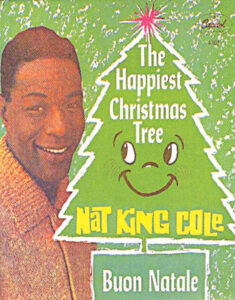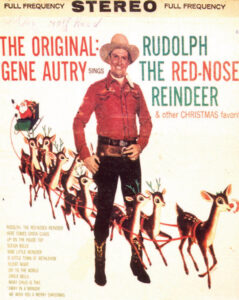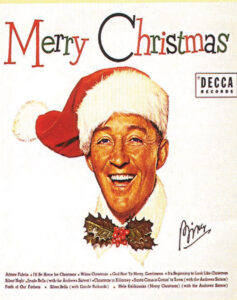 By Robert Reed
By Robert Reed Part of the enduring Christmas season has always been the music. For decades much of it was captured on phonograph records and colorful long playing albums. Today many of those well-packaged Yule tunes are sounding very collectible.
“In the past few years the growth of Christmas music has been obvious,” wrote author Tim Neely in the 1997 edition of the Goldmine Christmas Record Guide. “Many used record stores never remove their holiday offerings from sight; many collectors’ catalogs offer Christmas records all year, not just in November and December.”
By most measures the golden-era of Christmas records and albums lasted from the late 1940s until well into the 1970s. During that time recordings offered a wide range of Christmas fare. Shoppers could choose from western singer’s Gene Autry’s Rudolph the Red-Nosed Reindeer all the way to Yogi Yorgesson’s comic I Just Go Nuts At Christmas. Additionally scores of memorable singers and entertainers donned Santa suits for more traditional holiday fare.
 Typically the recordings were short-lived marketed only during the Christmas season and then discontinued. Many were based on a single ‘breakout’ hit which later headlined a full album. Other albums were simply based on the already broad appeal of a particular singer whose fans logically followed their work into the Yuletide season.
Typically the recordings were short-lived marketed only during the Christmas season and then discontinued. Many were based on a single ‘breakout’ hit which later headlined a full album. Other albums were simply based on the already broad appeal of a particular singer whose fans logically followed their work into the Yuletide season. Christmas records and subsequent albums were a part of a major change in the record industry during the latter 1940s. First was the boom in demand. By 1945 record sales had surpassed the 100 million mark, more than double what they had been just five years earlier. Next was the technology. At the time most records were in the 78 rpm form which meant each side could contain only about four minutes of music. Eventually Columbia Records developed a method of producing a long playing (33 rpm) record which provided 30 minutes of music on each side. Rather than group three or four 78s into one cumbersome (and heavy) album, all the songs could be contained on a single long-playing album.
Columbia Records first introduced the LP to the music-minded masses in 1948, but the reaction was mild. Instead of following the same course, RCA Vic- tor instead responded with the smaller 45 rpm record. All this led to what author Eric Kohler describes in the fine book In The Grove, Vintage Record Graphics, as the “war of speeds.”
 By the Christmas of 1949 customers could find seasonal music in heavy 78 rpm albums and in the lighter long playing form. Christmas Music with Ethel Smith at the organ, for example, was in a three-record 78 album. Decca also used the same form for Bing Crosby’s Merry Christmas album. LP choices included Christmas Music by Morton Gould, and Mario Lanza’s Christmas Songs.
By the Christmas of 1949 customers could find seasonal music in heavy 78 rpm albums and in the lighter long playing form. Christmas Music with Ethel Smith at the organ, for example, was in a three-record 78 album. Decca also used the same form for Bing Crosby’s Merry Christmas album. LP choices included Christmas Music by Morton Gould, and Mario Lanza’s Christmas Songs. As the decade of the 1950s developed the LP became the overwhelming choice for albums including Christmas albums, and the 45 became the dominant form for singles. After some bad experiences with 78-like paper sleeves, the record industry turned to cardboard with paper covering for albums. The cardboard not only protected the records but it was immediately graphic.
“Trends not withstanding,” according to Kohler, “the 1950s still produced some of the best cover designs in the illustrative and typographic genre.” Artists defined that period “in cover graphics and carried on the concept of highly stylized, instantly recognizable cover art.”
The LP album and the graphic cover became a perfect combination for the Christmas season.
Holiday albums early in that decade included Patti Page’s Christmas, Burl Ives’ Christmas in the Morning, Liberace’s Christmas at Liberace’s; and Eddie Fisher’s Christmas With Fisher. There were also long-expected album offerings from the likes of Rosemary Clooney, Perry Como and Bing Crosby. Later in the 1950s were the Christmas renditions and holidays albums of Nat King Cole, Connie Francis, Jimmy Rodgers, the Four Aces, Mitch Miller, and old blue eyes himself Frank Sinatra.
In 1957 RCA issued an Elvis Presley Christmas album in a variety of forms. The Elvis Christmas Album was sometime printed with a gold title and sometimes with a silver title. Some albums had a gatefold, and some included a bound booklet. Some had a prominent sticker, while others did not. Experts generally agree however that the most collectible of the Elvis Christmas album varieties was the red vinyl issue of that year, produced in very limited numbers. The album itself, as were many others, was later reissued for still other Christmas seasons.
The 1960s were grand times for the big high Christmas record and the accompanying Christmas album. Bobby Darin did The 25th Day of December, Nat King Cole did The Christmas Song, and Bobby Helms continued to offer versions of the immortal Jingle Bell Rock. The Osmonds provided, We Sing You A Merry Christmas, and Christmas With The Chipmonks starred a character named Alvin repeating a smash hit known plainly as The Chipmonk Song. As the 60s continued so did the entertainers and their Christmas music. Roy Rogers and Dale Evans did the Christmas Is Always album, Paul Revere and The Radiers did Christmas Past and Present, and Brenda Lee not surprisingly did an album called Merry Christmas From Brenda Lee. Then too there was Jim Nabors, Wayne Newton, Loretta Lynn, and Ferlin Husky. There was Christmas With the Platters, the Led Zepplin Show for Christmas Seals, and Stevie Wonder’s Someday at Christmas.
In 1970 the Jackson Five did a special Christmas album based on their rocking rendition of the single, Santa Claus is Coming to Town. The following year, another ‘family’, the Partridge Family offered A Partridge Family Christmas Card album. Some of the albums included an actual Christmas card while others had the image of a card printed on them. Even Flintstones family members got into the Christmas album act when Pebbles and Bam Bamm did a second release of their extended play recording featuring The Little Drummer Boy.
In addition to all the general interest Christmas records and albums, there were those offered to a special market. A particular album would be only available at a specific service station chain, or tire store, or television set dealer. Other Christmas albums were available only by catalog, or with mail-in premiums for a purchased product. Among collectors today there is a great deal of emphasis on the condition of Christmas albums of the past. Beyond the direct pull of nostalgia, such albums are sought mainly for their graphic appeal. They can make a very profound display for the holiday season by filling a wall or the corner of a room like other yuletide decorations.
Since visual appearance is vital, excessive wear, creasing, stains, and mouselunch munching detracts from the overall value of the Christmas presentation. Any original sleeves, lyric sheets, greeting cards, or other inclusions generally add to the value and prestige of the Christmas recording.
Recommended reading: Goldmine Christmas Record Price Guide by Tim Neely (Krause Publications).















Follow Us